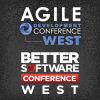Agile Development Conference & Better Software Conference West 2011

PRESENTATIONS
|
Cautionary Tales from Failed Scrum Adoptions
Although Scrum has become an integral software project management tool in many organizations, not all adoptions have gone well-or as well as they could have. By examining the business, technology, and cultural issues that block successful Scrum adoption, Rob Sabourin offers you the knowledge and tools you need to get the most out of your Scrum practices. Explore with Rob the organizational issues that he's encountered-inability to overcome corporate inertia and internal resistance to change-and bring your own experiences to share. |

Robert Sabourin, AmiBug.com |
|
Coding for Keeps: How to Write a Function
Functions are the basic building blocks of computer systems. Object-oriented classes are a way of packaging functions with shared data. Inheritance and polymorphism essentially are all about finding the right function. It’s all about functions! Get the picture? Chuck Allison explains that functions come in many varieties: static functions, polymorphic functions, generic functions, nested functions, higher-order functions, generator (aka stream) functions, coroutines, function closures, delegates, etc. |
|
|
Continuous Integration: Do It Continuously
No matter when it happens, integrating components is difficult. Tail-end integration, often called "big bang," is the hardest; it often leads "the hidden project"-you know, the one that occurs after everything is supposedly "done," when the team finally corrects all the integration defects. Steven “Doc” List describes how agile teams can use continuous integration to significantly reduce-if not eliminate-that hidden project. |
|
|
Cosmic Truths about Software Quality
Although everyone wants to build and use high quality products, software people often debate the meaning of "quality" and how to achieve it. Karl Wiegers has identified ten principles about quality that apply almost universally to software products. Learn why any software team that really cares about quality needs to understand these principles and implement development approaches consistent with them. |
|
|
Deception and Estimating: How We Fool Ourselves
Cognitive scientists tell us that we are hardwired for deception-overly optimistic about outcomes. In fact, we surely wouldn't have survived without this trait. With this built-in bias as a starting point, it's no wonder that software managers and teams almost always develop poor estimates. But that doesn't mean all is lost. We must simply accept that our estimates are optimistic guesses and continually re-evaluate as we go. |

Linda Rising, Independent Consultant |
|
Deception and Estimating: How We Fool Ourselves
Cognitive scientists tell us that we are hardwired for deception-overly optimistic about outcomes. In fact, we surely wouldn't have survived without this trait. With this built-in bias as a starting point, it's no wonder that software managers and teams almost always develop poor estimates. But that doesn't mean all is lost. We must simply accept that our estimates are optimistic guesses and continually re-evaluate as we go. |

Linda Rising, Independent Consultant |
|
Defect Prevention: A Tester's Role
Software delivery schedules are getting shorter and shorter as companies attempt to deliver products to their customers at a blinding pace. A critical role for testers and testing in this crazy world is identifying defects before they ever get to testing. Mike Ennis identifies key defect prevention techniques-walkthroughs, inspections, and reviews-that your test team needs to begin using-today. Yes, we know that these static analysis techniques are old, dull, and may seem boring; however, they actually work! |

Mike Ennis, Accenture |
|
Evaluating the Quality of Requirements: A Primer for Independent Verification
Would you tell your publisher to stop editing in the middle of your manuscript and publish your novel now? Of course not! Then, why would you tell your QA/test team to stop identifying problems with requirements documentation? All deliverables—and especially requirements—should undergo a rigorous assessment based on their quality attributes and measurable evaluation criteria. Mark Haynes describes quality models and attributes he has used to evaluate requirements documents. |
|
|
Everything You Wanted to Know ABout Cloud Computing But Were Afraid to Ask
What is Cloud Computing? |

Anthony Voellm, Google, Inc. |
|
Faltering Projects: Getting Them Back on Track
Are you concerned that your project is in trouble? Perhaps the team has missed some deadlines. No one can show a demo. The testers are finding more defects that anyone expected. And, because you are starting to have delays, the stakeholders want more features in this release. You know that things are not hunky-dory with your project. Johanna Rothman first discusses the measurements you can take to evaluate progress-cumulative flow, fault feedback ratio, and defect trends. |

Johanna Rothman, Rothman Consulting Group, Inc. |


